The Unbearable Lightness of Being, 1988, directed by Philip Kaufman, screenplay by Jean-Claude Carrière and Philip Kaufman, from the novel by Milan Kundera.
The back of the Criterion edition of The Unbearable Lightness of Being refers to the movie as "the screen version of Milan Kundera's 'unfilmable' novel." The Unbearable Lightness of Being isn't the most unfilmable novel ever written, but it's pretty damn impossible to imagine it on film while you're reading it. (What is the most unfilmable novel ever written? Beckett's The Unnamable, with honorable mentions for Gravity's Rainbow, Pale Fire, and of course Ulysses—noting for the record that there are two (!) films of Ulysses).
So what makes a novel unfilmable? Structural complexity and stylistic experimentation don't help, but in the right hands they can be as great on screen as on the page. Novels of ideas aren't easy, but they can also be cinematic; think of A Clockwork Orange. The Unbearable Lightness of Being is a structurally complex, stylistically experimental novel of ideas, but that's not what makes it unfilmable. To give you a sense of the problem, here's the complete second chapter:
If every second of our lives recurs an infinite number of times, we are nailed to eternity as Jesus Christ was nailed to the cross. It is a terrifying prospect. In the world of eternal return the weight of unbearable responsibility lies heavy on every mood we make. That is why Nietzsche called the idea of eternal return the heaviest of burdens (das schwerste Gewicht).
If eternal return is the heaviest of burdens, then our lives can stand out against it in all their splendid lightness.
But is heaviness truly deplorable and lightness splendid?
The heaviest of burdens crushes us, we sink beneath it, it pins us to the ground. But in the love poetry of every age, the woman longs to be weighed down by the man's body. The heaviest of burdens is therefore simultaneously an image of life's most intense fulfillment. The heavier the burden, the closer our lives come to the earth, the more real and truthful they become.
Conversely, the absolute absence of a burden causes man to be lighter than air, to soar into the heights, take leave of the earth and his earthly being, and become only half real, his movements as free as they are insignificant.
What then shall we choose? Weight or lightness?
Parmenides posed this very question in the sixth century before Christ. He saw the world divided into pairs of opposites: light/darkness, fineness/coarseness, warmth/cold, being/nonbeing. One half of the opposition he called positive (light, fineness, warmth, being), the other negative. We might find this division into positive and negative poles childishly simple except for one difficulty: which one is positive, weight or lightness?
Parmenides responded: lightness is positive, weight negative.
Was he correct or not? That is the question. The only certainty is: the lightness/weight opposition is the most mysterious, most ambiguous of all.
So imagine you're Philip Kaufman or Jean-Claude Carrière. How do you film this? It's not completely impossible to include something like this in a film: you could put it in a voiceover, or have a Dan Brown-style "conversation between experts," or have a character give an academic lecture (another of Brown's favorite "techniques"). But such solutions make awkward the kind of discursiveness that seems natural in a novel (which makes Dan Brown's use of them all the more baffling). But as much as I'd love to spend the rest of this essay talking about how terrible The Da Vinci Code is, I'm going to back away from the precipice. Unlike certain pulp authors I could name, Kundera is verbal more than visual, which doesn't make for easy adaptation. You can't film an essay.
Kaufman and Carrière's solution is to cut virtually all of Kundera's philosphical asides, rearrange the events of the novel in chronological order, eliminate the narrator entirely, cut one of the four main characters down to a few minutes of screentime, and in general turn the movie into something that could be mistaken for a conventional love story. So what's left after this radical surgery? Lena Olin, to start.
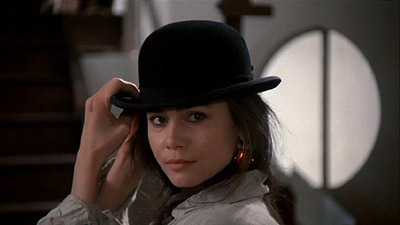
And Juliete Binoche.
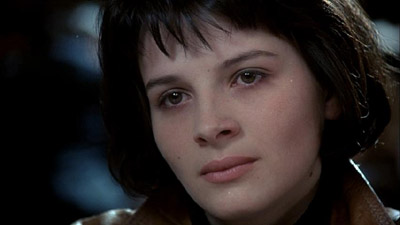
Also, Lena Olin and Juliet Binoche.
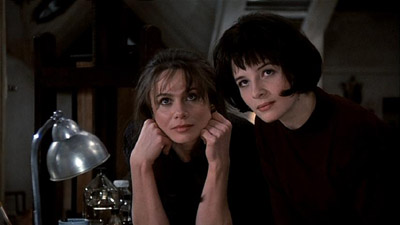
The good news about Kundera's novel is that even after you've turned it into a linear narrative, you still have strong characters and at least one iconic visual (a woman in a bowler). And it doesn't hurt to have two of the most accomplished actresses in the world making their English-language debuts. Lena Olin plays Sabina, one of the main character's (many) mistresses; Binoche is Tereza, the woman he finally settles down with. The main character, Tomas, is played by Daniel Day-Lewis at his most trustworthy and reliable:
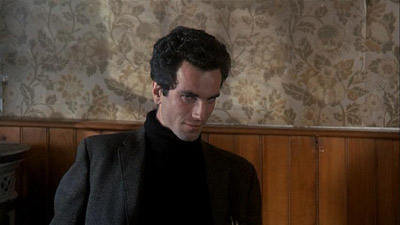
The film, like the novel, follows Tomas from 1968 through fall of 1969, if I have the chronology right. The dates are indistinct except for the central event of the novel: the Soviet invasion of Czechoslovakia in August of 1968. It's worth brushing up on this before watching the movie, because unlike most films that deal with parts of history Americans don't know too well (everything except World War II, in other words), The Unbearable Lightness of Being doesn't spend much time on exposition. And to be honest, it doesn't spend much time on politics either, which is strange for a movie with an invasion at its center. I was talking with my friend Angela about Good Bye Lenin! (which I highly recommend) and she said she really likes "stories where major world-changing events are always just an element in someone's life and not the only one." The Unbearable Lightness of Being is definitely one of those stories, but sometimes I think Kaufman gives short shrift to these events, which are essential to the novel. On the commentary, Carrière says something about how happy he is that the sex scenes in the movie aren't ornamental, as they are in most studio films. He's right; the movie handles eroticism very frankly and realistically. But by focusing on the central love triangle above all, Kaufman risks making world history seem ornamental.
If you know the novel, you'll know it's strange to describe it as a love "triangle." Also missing in this adaptation is the fourth character in Kundera's quartet, Sabina's lover Franz. He still makes an appearance, and Derek de Lint does a fine job playing him, so guilelessly that it's immediately apparent that Sabina is going to break his heart:
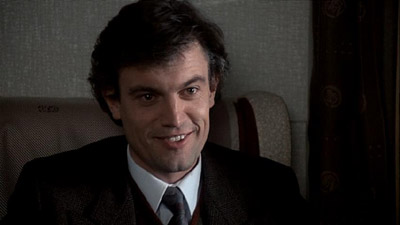
But Franz has very little screen time; the first two-thirds of the film are framed like a traditional love triangle between Tomas, Tereza, and Sabina. In the novel, Franz's overly optimistic leftism and naïveté provides a lightness to balance the weight of the other character's actual experience of communism. But without knowing his politics, or his wife, or seeing his tragicomic end in Cambodia, Franz seems out of place, a minor character that we spend too much time with. The result is, unfortunately, to make Sabina's betrayal seem cruel.
On the other hand, the movie clocks in at 172 minutes as is, so it seems unrealistic to wish more of the novel was there. And even without context, the Soviet invasion of Czechoslovakia is spectacular:

If you think that shot looks a little expensive for an art house movie, you're right. During the actual invasion, students at the Prague film school shot everything they could, and Kaufman uses this stock footage liberally. It's a textbook case of making something amazing on a budget: cutting from Tereza taking a photograph:
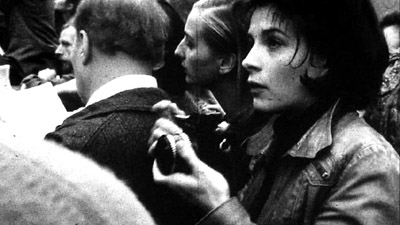
To what she's photographing:
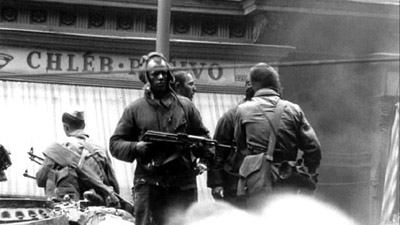
Or cutting from a crowd fleeing tanks:
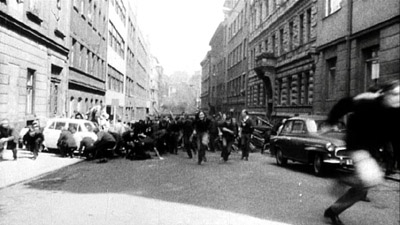
To Tereza and Tomas reacting and running away themselves:
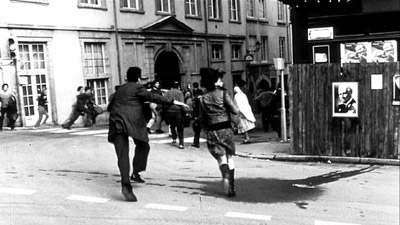
Presented just as stills, it sounds like something Ed Wood would do, but the cuts are very fast and the sequence feels seamless. I didn't realize that any stock footage was being used (and was wondering how on earth they'd staged some of the things I was seeing) until this shot:
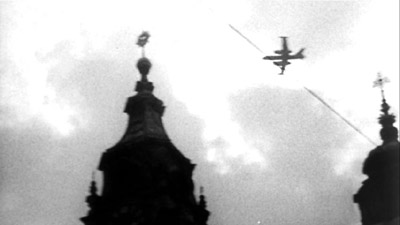
You couldn't fly a vintage Soviet recon plane over St. Vitus Cathedral in 1986, and an elaborate model shot for two seconds of film would have been excessive. As great as this sequence is on its own, in the rest of the film the Soviet invasion is sometimes treated as just another obstacle for Tereza and Tomas to overcome (and Carrière explicitly refers to it as such on the commentary). As the IMDB puts it, "In 1968, a Czech doctor with an active sex life meets a woman who wants monogamy, and then the Soviet invasion further disrupts their lives." That's a lot like the summary of the 1953 version of Titanic I discovered while writing about A Night To Remember: "Their problems soon seem minor when the ship hits an iceberg."
But look: as the excerpt from the novel shows, you couldn't possibly make a movie that was "faithful to the book." The novel's main concerns aren't historical anyway, they're philosophical. And nobody's made a good movie about philosophy yet. Kaufman and Carrière chose to focus on three of the novel's characters, and they got brilliant performances from everyone involved. And the tone is right throughout; "everything is illuminated by the aura of nostalgia," to quote the novel. Evaluated as a character-based love story, the movie succeeds; all three of the characters are wonderfully fleshed out, and by the end, as Roger Ebert noted, you have a sense of the rhythms of their lives. And the ending itself, the one time the film breaks chronology, is perfect, both in tone and execution.
It's hard to criticize the filmmakers for recognizing what works on film and what doesn't. If you're going to make a movie about sex, politics, and philosophy, guess which parts are going to work best on screen? There's one scene that crystallized this for me. Tomas is telling Sabina why he hasn't thrown Tereza out of his apartment (up to this point he's had a no-overnight-guests rule).
If I had two lives, in one life I could invite her to stay at my place, and in the second life I could kick her out. Then I could compare and see which had been the best thing to do. But we only live once. Life's so light. Like an outline we can't ever fill in or correct... make any better. It's frightening.
Tomas's line here is one of the points where the film is closest in its concerns to the novel. Sabina listens to Tomas for a minute and then, mid-sentence, rolls her eyes.
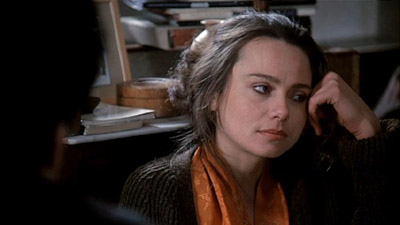
The camera stays on Lena Olin.
Randoms:
- The commentary track is well worth listening to for practical advice about editing. Walter Murch was one of the commenters and for the most part talks about specific techniques he used when cutting the movie, most of them useful and all of them interesting. Just one example: love scenes between Tomas and Sabina feature a lot of mirrors. When you're cutting between a shot in a mirror and the real world, of course, the image reverses itself. It takes the brain about a half-second to parse this, so if you're cutting on an action, you need to have some overlap to cover the cut, or the action doesn't seem continuous. For example, in the two shots below, Tomas is pulling Sabina's robe off her right shoulder in one continuous motion. In this frame, the robe is nearly off her shoulder entirely:
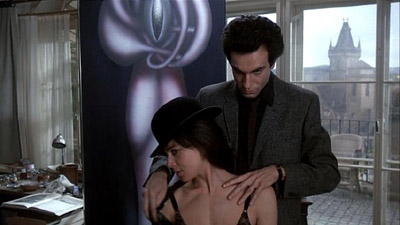
- But in the next frame, after the cut to a mirror image, his hand is back near her collarbone and the action repeats.
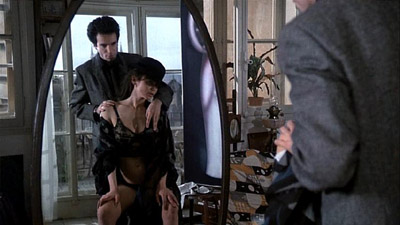
- If Murch had cut to the next frame of motion instead of overlapping, the action would have looked jerky, but as it is, the brain processes it like any other cut on motion, and Tomas's hand moves smoothly. This overlap must have made the sound synchronization a lot of trouble, but Murch was sound editor on The Conversation so I doubt it phased him too much.
- Murch also seems to have a very good sense of the novel's structure. I wonder more generally if editors are more sensitive to structure in novels, since they're used to cutting and restructuring film. In any event, he was the one person on the commentary who mentioned the way the novel retells the key events in different ways and from different characters' perspectives. And he seems to have had a great deal of creative influence. Take the scene where Tereza, angry at Tomas, sleeps with a patron of the bar where she's working. Kaufman shot coverage of both Tereza and her lover; it was Murch who decided to cut the scene using only shots where her lover's face is obscured, to give a sense of what Tereza thinks anonymous sex must be like for her husband. I don't know if this kind of influence is typical but I suspect it isn't.
- At the risk of turning this section into the Walter Murch hour, I should note that he has one other piece of advice for editors: never visit the set. Murch edited Apocalypse Now, and I guess anybody who could stay off that set did. But he has another reason to recommend this. If you see the difficulties involved in getting a particular shot to work, you may prize it more highly than you should; if it takes all day to get the light just right, you might not notice that the result is boring. By the same token, if you know what footage is just people goofing around, you might assume nothing in it is good and miss something great to use. The editor is the only person who can provide a new perspective that late in the creative process, and it's good to have that. However, I doubt Murch was able to take his own advice; the last scenes with Sabina were shot at his house.
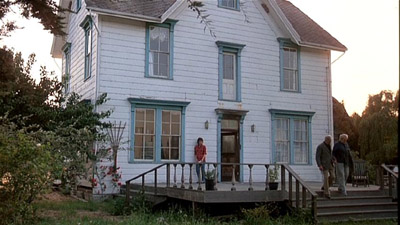
- And the old man walking down the front stairs is Niven Busch, who was a co-writer on the screenplay for The Postman Always Rings Twice and the novel Duel in the Sun. What's he doing in a minor role in this movie? Your guess is as good as mine.
- Speaking of minor roles, the engineer who Tereza sleeps with during her one experiment in infidelity is played by Stellan Skarsgård, who had already mastered the creepiness that would serve him so well in Insomnia.
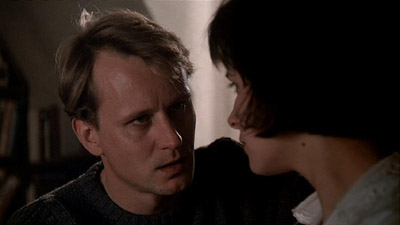
- Not all of the destruction in the Soviet invasion sequence is from stock footage. The production rented a few vintage Soviet tanks from a French general who collected them. I don't know the model of tank, but the plane flying over St. Vitus appears to be a YAK25-RV, a high-altitude recon craft. What it's doing at low altitude over Prague I don't know, but it's the only plane that has that wing shape. (Yes, I'm obsessive enough to try to ID the plane).
- The shot below seemed very familiar to me but I can't remember what it reminded me of.
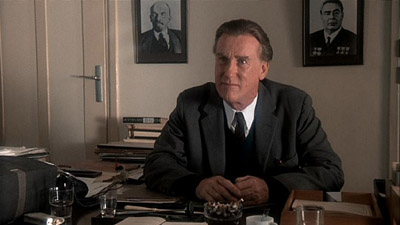
- I'm thinking specifically of the photos on the wall on either side of the head of the man at the desk. I want to say it's from 8½ or Harold and Maude, not that those two are particularly linked anywhere but my troubled mind. Or The 400 Blows?
- Kaufman tells a great story about Stanley Kubrick on the commentary. There's a scene in the middle of the film where Sabina poses nude for Tereza to photograph and vice-versa. It is, as you would expect, pretty remarkable. Kubrick apparently complimented Kaufman on the film in general, and that sequence in particular. Because he was impressed by the vintage Praktica LTL camera that Tereza uses to photograph. Only Kubrick would see something like this:
Update: I figured it out; it's from Harold and Maude; but it isn't quite the way I remembered it. See the comments for details.
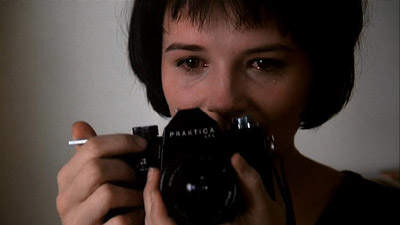
- and find his eye irresistibly drawn to the camera. (By the way, the camera isn't just vintage, but anachronistic; the Praktica LTL didn't start production until December 1970—and yes, I'm just the kind of dork who would try to answer Kubrick's question—but I sure wasn't thinking about it while I was watching the movie).
- Worst pun you could make when writing about a Kundera adaptation that, despite being unfaithful to the novel, is still a very good film: "C'est magnifique, mais ce n'est pas Kundera!" Thank you, thank you, I'm here all week.

